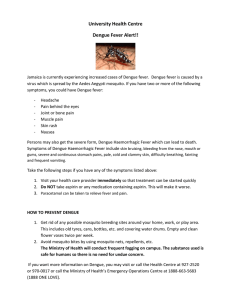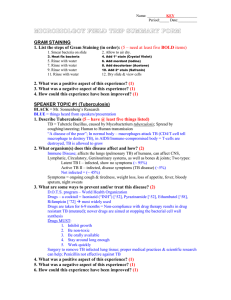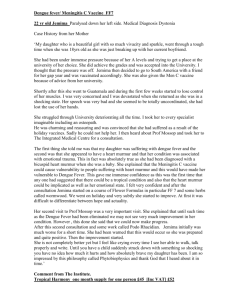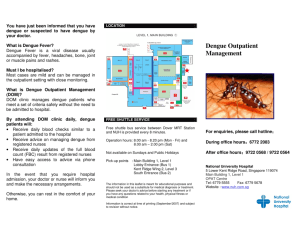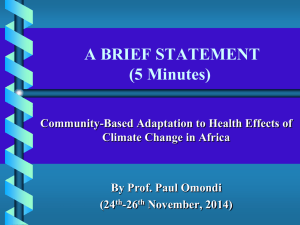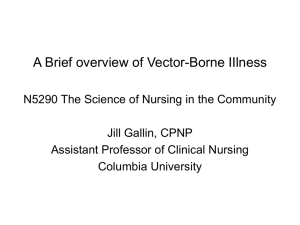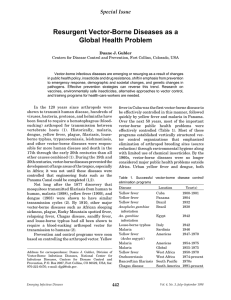Tropical Diseases
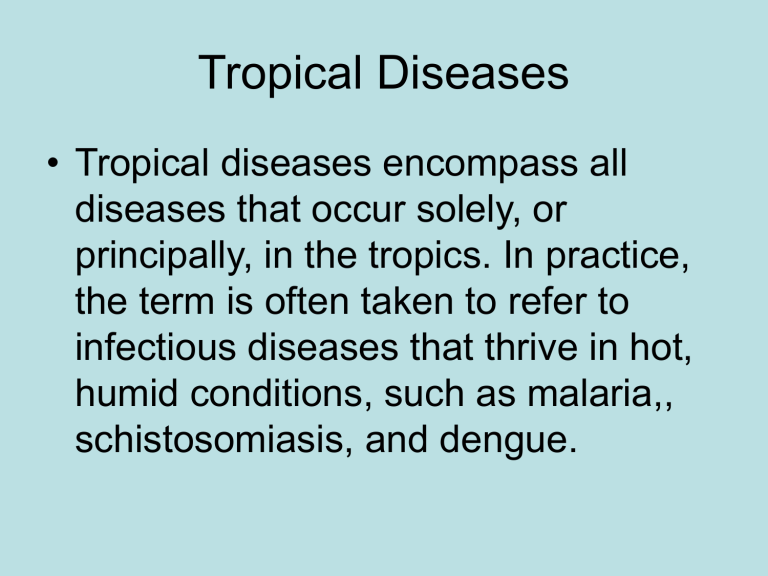
Tropical Diseases
• Tropical diseases encompass all diseases that occur solely, or principally, in the tropics. In practice, the term is often taken to refer to infectious diseases that thrive in hot, humid conditions, such as malaria,, schistosomiasis, and dengue.
Neglected Tropical diseases
• The people who are most affected by these diseases are often the poorest populations, living in remote, rural areas, urban slums or conflict zones. Neglected tropical diseases persist under conditions of poverty and are concentrated almost exclusively in impoverished populations in the developing world.
Climate change integrated framework
Why climate change impacts tropical diseases?
Elevated temperature
• Shortening the develop cycle of pathogen
• Hot weather + CO2 = biomass, shelter
• Enhancement of bacterial survivals
Increased rainfall
• Survival and transmission of water-borne diseases
• Breeding sites
Drought and flood
• Water contaminated by fecal and rat urine
• Lack of food and fresh water, physical damage, overcrowding
Malaria
• Malaria is caused by a one-celled parasite.
Female mosquitoes pick up the parasite from infected people when they bite to obtain blood needed to nurture their eggs.
Inside the mosquito the parasites develop and reproduce. When the mosquito bites again, the parasites mix with its saliva and pass into the blood of the person being bitten.
Symptoms
• Malaria parasites multiply rapidly in the liver and then in red blood cells of the infected person. One to two weeks after a person is infected the first symptoms of malaria appear: usually fever, headache, chills and vomiting. If not treated promptly with effective medicines, malaria can kill by infecting and destroying red blood cells and by clogging the capillaries that carry blood to the brain or other vital organs.
Dengue
• Dengue is transmitted by the bite of an Aedes mosquito infected with any one of the four dengue viruses. Symptoms appear in 3 –14 days
(average 4 –7 days) after the infective bite.
Dengue fever is a severe, flu-like illness that affects infants, young children and adults. There is no specific treatment for dengue fever.
Dengue haemorrhagic fever is a potentially lethal complication but early clinical diagnosis and careful clinical management by experienced physicians and nurses often save lives.
Dengue (cont)
• More than 70% of the disease burden is in
South-East Asia and the Western Pacific area.
Africa and the Eastern Mediterranean are much less affected. In Latin America and the
Caribbean, the incidence and severity of disease are increasing rapidly. Increase in international air travel is facilitating the rapid global movement of dengue viruses. This increases the risk of dengue haemorrhagic fever epidemics by introducing new dengue viruses into susceptible populations.
Leprosy
• Leprosy is a chronic disease caused by a bacillus,
Mycobacterium leprae.
Official figures show that more than 213 000 people mainly in Asia and Africa are infected, with approximately
249 000 new cases reported in 2008.
• Leprosy is not highly infectious. It is transmitted via droplets, from the nose and mouth, during close and frequent contacts with untreated cases.
Schistosomiasis
• Schistosomiasis is a chronic disease caused by parasitic worms.
• An estimated 700 million people worldwide may be at risk of infection as their agricultural, domestic and recreational activities expose them to infested water.
• More than 207 million people are infected worldwide – most live in poor communities without access to safe drinking water and adequate sanitation.
Cholera
• Cholera is an acute diarrhoeal disease that can kill within hours if left untreated.
• There are an estimated 3 –5 million cholera cases and 100 000 –120 000 deaths due to cholera every year.
• Up to 80% of cases can be successfully treated with oral rehydration salts.
• Provision of safe water and sanitation is critical in reducing the impact of cholera and other waterborne diseases.
• Oral cholera vaccines are considered an additional means to control cholera, but should not replace conventional control measures.
Yellow fever
• Yellow fever is an acute viral haemorrhagic disease transmitted by infected mosquitoes.
The "yellow" in the name refers to the jaundice that affects some patients.
• Up to 50% of severely affected persons without treatment will die from yellow fever.
• There are an estimated 200 000 cases of yellow fever, causing 30 000 deaths, worldwide each year.
• The virus is endemic in tropical areas of
Africa and Latin America, with a combined population of over 900 million people.
The Global Outbreak Alert and
Response Network
• Objectives
• The Global Outbreak Alert and
Response Network contributes towards global health security by:
• combating the international spread of outbreaks
• ensuring that appropriate technical assistance reaches affected states rapidly
• contributing to long-term epidemic preparedness and capacity building.
• http://www.who.int/csr/outbreak network/en/

